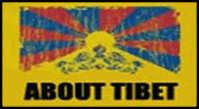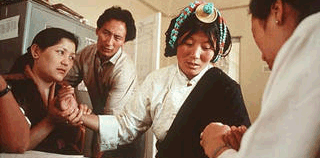
The Tibetan medical system is one of the world's oldest known medical traditions. It is an integral part of Tibetan culture and has been developed through many centuries. We believe that the origin of the Tibetan medical tradition is as old as civilization itself. Because humankind has depended on nature for sustenance and survival, the instinctive urge to health and accumulated knowledge has guided us to discover certain remedies for common ailments from natural sources. For example, applying residual barley from chang (Tibetan wine) on swollen body parts, drinking hot water for indigestion, and using melted butter for bleeding are some of the therapies that arose from pratical experience and gradually formed the basis for the art of healing in Tibet. The Tibetan medical heritage is based on the book of the Four Tantras (rgyud-bzhi), which remains the fundamental medical text even today During the pre-buddhist era, Tibet had religious and cultural influences from the indigenous Bon tradition. There is some evidence to suggest that several forms of medical practice existed at that time. The precise influence of these practices on the evolution of the Tibetan medical tradition, however, is unclear.
Tibetan medicine is a science, art and philosophy that provides a holistic approach to health care. It is a science because its principles are enumerated in a systematic and logical framework based on an understanding of the body and its relationship to the environment. It is an art because it uses diagnostic techniques based on the creativity, insight, subtlety and compassion of the medical practitioner. And it is a philosophy because it embraces the key Buddhist principles of altruism, karma and ethics.
Buddhist philosophy states that everything in the universe is in a constant state of flux - that all phenomenon are characterised by impermanence, and that the only permanent feature is impermanence itself. As Buddha said, "No matter whether perfect beings arise or not, it remains a fact, and a hard necessity of existence, that all creations are transitory." It is this impermanence that causes each and every being to suffer at one stage or another. Suffering is thus not accidental but springs from a specific cause, whether from this life or a previous life. Only through proper learning and the genuine practice of Dharma can liberate from the vicious cycle of suffering.
Tibetan medical theory states that everything in the universe is made up of the five proto-elements:
1. sa ( Earth )
2. chu ( Water )
3. me ( Fire )
4. rLung ( Wind )
5. Nam-mkha ( Space )
Although all five proto-elements are responsible for the formation of each tissue cell, each element has a specific influence:
1. sa exerts a greater influence over the formation of muscle cells, bones, the nose and the sense of smell
2. chu is responsible for the formation of blood, body fluids, tongue and the sense of taste
3. me is responsible for body temperature, complexion, the eyes and the sense of sight
4. rLung is responsible for breathing, skin and the sense of touch and
5. nam-mkha is responsible for body cavities, the ears and the sense of hearing
The Three Principle Energy1. rLung (wind) is one of the three principle energies of the body which manifests the the nature of Air element. It is characterised by rough, light, cold, subtle, hard and mobile. It is responsible for the physical and mental activities, respiration, expulsion of urine, faces, fetus, menstruation, spitting, burping, speech, gives clarity to sense organs, sustains life by means of acting as a medium between mind and body.
2. mKhris-pa (Bile)basically has the nature of fire. It is characterised by oily, sharp, hot, light, fetid, purgative and fluidity. mKhris-pa is responsible for hunger, thirst, digestion and assimilation, promotes bodily heat, gives lustre to body complexion and provides courage and determination.
3. Bad-kan (Phlegm) is cold in nature and is characterised by oily, cool, heavy, blunt, smCTAh, firm and sticky. Bad-kan is responsible for firmness of the body, stability of mind, induces sleep, connects bodily joints, generates tolerance and lubricates the body.
For details refer the following sites.
Introduction to Tibetan Medicine
Tibetan Medical Schools
Medicines, Herbs, Etc.
Books on Tibetan Medicine
Tibetan and Himalayan Digital Library Medical Collections
Prof. Pasang Yonten Arya's Tibetan Medicine website
Kailash Institut (German)
Dharma-Haven's Tibetan Medicine Site
Tibetan Medicine Thangkas of Dharmapala Centre










Web designed and developed by: Tenzin Sherab (Longsho leader) with funding from National Endownment for Democracy (NED)

